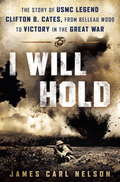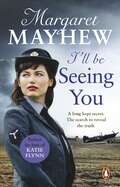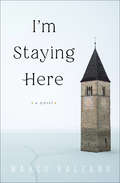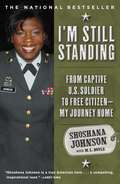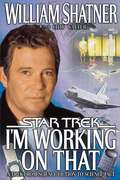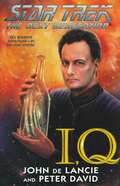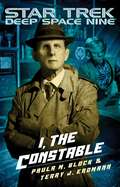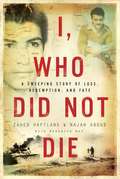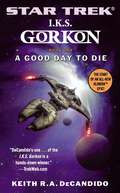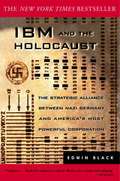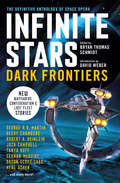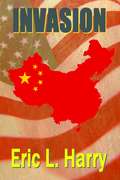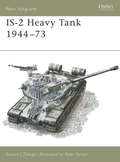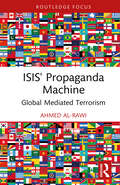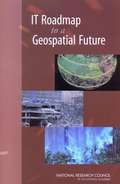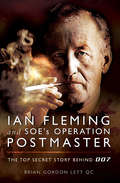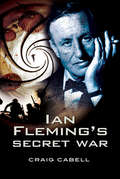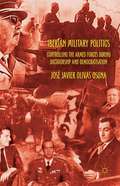- Table View
- List View
I Will Hold: The Story of USMC Legend Clifton B. Cates, from Belleau Wood to Victory in the Great War
by James Carl NelsonThe incredible true story of Clifton B. "Lucky" Cates, whose service in World War I and beyond made him a legend in the annals of the Marine Corps.Cates knew that he and his small band of marines were in a desperate spot. Before handing the note over to a runner, he added three words that would resound through Marine Corps history:I WILL HOLDFrom the moment he first joined the Marine Reserves of the American Expeditionary Force in World War I, Clifton B. Cates was determined to make his mark as a leader. Little did he know what he would truly accomplish in his legendary career.Not as well-known as his contemporaries such as Alvin C. York, his fame would not come from a single act of heroism but from his consistent and courageous demeanor throughout the war and beyond.In the bloody second half of 1918 with the 6th Marine Regiment, he was awarded the Navy Cross, the Distinguished Service Cross, the Purple Heart, the Silver Star, was recognized by the French government with the Legion of Honor and the Croix de Guerre, and earned the nickname "Lucky."I Will Hold is the inspiring, brutally vivid, and incredible true life story of a Marine Corps legend whose grit and unstoppable spirit on the battlefield matched his personal drive and sage wisdom off of it.INCLUDES PHOTOS
I'd Walk With My Friends If I Could Find Them: A Novel
by Jesse GoolsbyIn this powerful debut novel, three American soldiers haunted by their actions in Afghanistan search for absolution and human connectionin family and civilian life. Wintric Ellis joins the army as soon as he graduates from high school, saying goodbye to his girlfriend, Kristen, and to the backwoods California town whose borders have always been the limits of his horizon. Deployed in Afghanistan two years into a directionless war, he struggles to find his bearings in a place where allies could at any second turn out to be foes. Two career soldiers, Dax and Torres, take Wintric under their wing. Together, these three men face an impossible choice: risk death or commit a harrowing act of war. The aftershocks echo long after each returns home to a transfigured world, where his own children may fear to touch him and his nightmares still hold sway. Jesse Goolsby casts backward and forward in time to track these unforgettable characters from childhood to parenthood, from redwood forests to open desert roads to the streets of Kabul. Hailed by Robert Olen Butler as a &“major literary event,&” I&’d Walk with My Friends If I Could Find Them is a work of disarming eloquence and heart-wrenching wisdom, and a debut novel from a writer to watch.
I'll Be Seeing You: A spellbinding and emotional wartime novel of love and secrets
by Margaret MayhewAn enthralling novel of love and secrets from the Second World War, perfect for fans of Katie Flynn and Fiona Valpy.READERS ARE LOVING I'LL BE SEEING YOU!"I consider Margaret Mayhew to be an exceptional author and this is one of her best offerings!" - 5 STARS"Exceptional story kept me enthralled until the end. I loved the way this book was written." - 5 STARS"This is the first book I have read by Margaret Meyhew. It won't be the last." - 5 STARS"Absolutely loved this story, so much so I just stayed up all night reading it , desperate to see how it unfolded, yet hating seeing it come to an end. So well written and researched." - 5 STARS*********************************WHAT IF EVERYTHING YOU BELIEVED TURNED OUT TO BE A LIE?1992: When Juliet Porter's mother dies, she leaves her some old letters and a photograph which shatter everything Juliet thought she knew about her upbringing. Discovering her real father was an American bomber pilot who met her mother while serving in England during the Second World War, she sets out to trace him...1944: Daisy, Juliet's mother, is in the WAAF and plans to marry the American bomber pilot she has fallen deeply in love with once his tour is over. But one day he is shot down over France and posted missing, presumed dead. Pregnant and grieving, she marries Vernon - a long term admirer - only to discover at the end of the war that her pilot has survived...
I'll Be Seeing You: Code Talker Chronicles (Code Talker Chronicles #1)
by Eileen CharbonneauLuke Kayenta and his childhood friend Nantai Riggs are young shepherds of the Navajo reservation in Arizona. They volunteer for an experiment: to come up with an uncrackable code based on their language to be used by the US as it enters World War II. They fly into New York to join the spy agency the Office of Strategic Services (OSS). While on the airfield, Luke catches sight of a young woman. He is first enchanted, then heartsick when he finds that Kitty Charante is the devoted wife of his Canadian RAF pilot and instructor in espionage. Their paths will cross again.
I'll Be Your Sweetheart: A heart-warming saga of mothers, daughters and best friends (Molly and Nellie series, Book 8)
by Joan JonkerWhile Molly and Nellie play detective, for Molly's youngest, there's also a party to plan and a boy to impress... Joan Jonker brings us another instalment of her hugely popular Molly and Nellie series in I'll Be Your Sweetheart, as the two friends get up to more mischief in their beloved Liverpool. Perfect for fans of Katie Flynn and Anne Baker. Not a day goes by without Molly Bennett and Nellie McDonough counting their blessings. But when an elderly neighbour, Flora Parker, is robbed of her most treasured possession, and left without a penny to her name, the two friends jump at the chance of setting their detecting skills in motion. Meanwhile, Molly's youngest daughter, Ruthie, and her best friend, Bella, are making plans for their joint sixteenth birthday party. Ruthie is determined to look glamorous, a real knock out, to catch the eye of a certain boy for whom she's got more than a soft spot. What readers are saying about I'll Be Your Sweetheart: 'This is another excellent read from Joan Jonker. We are back with her most popular characters Molly and Nellie, and as usual, you feel right at the centre of the action. Once again Molly and Nellie are called on to help a neighbour and there's lots of fun and laughter before things reach the feel-good conclusion I've come to expect from Joan. First class as usual!'
I'm Deborah Sampson: A Soldier in the War of the Revolution
by Patricia ClappRelates the experiences of the woman who disguised herself as a man in order to enlist and fight in the American Revolution.
I'm Staying Here: A Novel
by Marco BalzanoA mother recounts her life story to her long-lost daughter in this sweeping historical novel about a community torn between Italian fascism and German Nazism. In the small village of Curon in South Tyrol, seventeen-year-old Trina longs for a different life. She dedicates herself to becoming a teacher, but the year that she qualifies—1923—Mussolini&’s regime abolishes the use of German as a teaching language in the annexed Austrian territory. Defying their ruthless program of forced Italianization, Trina works for a clandestine network of schools in the valley, always with the risk of capture. In spite of this new climate of fear and uncertainty, she finds love and some measure of stability with Erich, an orphaned young man and her father&’s helper. Now married and a mother, Trina&’s life is again thrown into uncertainty when Hitler&’s Germany announces the &“Great Option&” in 1939, and communities in South Tyrol are invited to join the Reich and leave Italy. The town splits, and ever-increasing rifts form among its people. Those who choose to stay, like Trina and her family, are seen as traitors and spies; they can no longer leave the house without suffering abuse. Then one day Trina comes home and finds that her daughter is missing… Inspired by the striking image of the belltower rising from Lake Resia, all that remains today of the village of Curon, Marco Balzano has written a poignant novel that beautifully interweaves great moments in history with the lives of everyday people.
I'm Staying with My Boys: The Heroic Life of Sgt. John Basilone, USMC
by Jim Proser Jerry CutlerThe authorized biography of the legendary Marine featured in HBO’S The Pacific, a true American hero who gave his life in service during World War II.I’m Staying with My Boys is a firsthand look inside the life of one of the greatest heroes of the Greatest Generation. Sgt. John Basilone held off three thousand Japanese troops at Guadalcanal after his fifteen-member unit was reduced to three men. At Iwo Jima he single-handedly destroyed an enemy blockhouse, allowing his unit to capture an airfield. Minutes later he was killed by an enemy artillery round. He was the only Marine in World War II to have received the Medal of Honor, the Navy Cross, and a Purple Heart, and is arguably the most famous Marine of all time.I’m Staying with My Boys is the only family-authorized biography of Basilone, and it features photographs never before published. Distinctive among military biographies, the story is told in first person, allowing readers to experience his transformation, forged in the horrors of battle, from aimless youth to war hero known as “Manila John.”Praise for I’m Staying with My Boys“Everyone should read this book, the story of a true American hero. I served with John Basilone and I can hear his voice on every page.” —Thomas O. Nass, 5th Marine Division, World War II“This book about the legendary John Basilone is presented in such a personal style that one would believe that “Manila John” is still alive. Not since William Manchester authored his memoir Goodbye, Darkness twenty-five years ago has a book been written about one man that seems so authentic.” —Col. Ken Jordan, USMC (Ret.)
I'm Still Standing
by Shoshana Johnson M. L DoyleSHOSHANA HOLDS NOTHING BACK in this harrowing account of an ordinary woman caught in extraordinary circumstances. She reveals decisions made by chain of command that may have led to her twenty-two-day imprisonment, describes the pain of post-traumatic stress disorder, and shares the surprising story of how a specialist in a maintenance company ended up on the front lines of war. Told with exceptional bravery and candor, I'm Still Standing is at once a provocative look at the politics of war and the unforgettable story of a single mom and soldier who became an American hero. In March 2003, Operation Iraqi Freedom made world headlines when a U. S. army convoy was attacked en route to Baghdad. Shoshana Johnson became the first black female prisoner of war in United States history.
I'm Working on That: A Trek From Science Fiction to Science Fact (Star Trek)
by William Shatner Chip Walter"Beam me up, Scotty."® During the 1960s, in an age when the height of technology was a crackly AM transistor radio, Star Trek envisioned a time when communication devices worked without wires. "Working" Computers of the decade took up entire climate-controlled rooms and belonged only to the government and a few very large corporations. Yet Captain Kirk had one small enough to sit on the top of his desk -- and it talked back to him. "Ahead, Warp Factor 2" While man still hadn't walked on the moon, the crew of the Starship Enterprise® traveled between star systems faster than the speed of light. Its crew was able to walk on other worlds. Over the past three decades, Star Trek has become a global phenomenon. Its celebration of mankind's technical achievements and positive view of the future have earned it an enduring place in the world's psyche. It has inspired countless viewers to become scientists, inventors, and astronauts. And they, in turn, have wondered if they could make even a little piece of Star Trek real in their own lifetime. As one noted scientist said when he saw a plywood, plaster and plastic set that represented the ship's warp engines, "I'm working on that." As in his missions aboard the fictional Starship Enterprise, William Shatner, the actor who is Captain James T. Kirk, and his co-author, Chip Walter, take us on an adventure to discover the people who are working on the future we will all share. From traveling through space at warp speeds to beaming across the continent, noted scientists from Caltech to MIT explore the realms of what was once considered improbable and show how it just might be possible.
I, Q: Star Trek The Next Generation (Star Trek: The Next Generation)
by Peter David John de LancieThe enigmatic entity known as Q remains one of the greatest mysteries in the universe, yet no one, perhaps, understands Q as well as actor John de Lancie, who has played Q on television for more than a decade—now de Lancie and Peter David, bestselling author of acclaimed novels Q-in-Law and Q-Squared, have joined forces to send Q on an unforgettable cosmic odyssey, told from the mischievous trickster's own unique point of view.The Maelstrom, a metaphysical whirlpool of apocalyptic proportions, is pulling all of reality into its maw, devouring the totality of time and space while bringing together people and places from throughout the universe. The Q Continuum pronounces that the end of everything has come, but Q refuses to meekly accept the end of all he has known. Defying the judgement of the Continuum, he sets out to derail doomsday—at whatever the cost. Q has been everywhere and done everything, but now he's in for a cosmic thrill ride beyond even his own astonishingly unlimited imagination. Old friends and adversaries wait in unexpected places, transcendent hazards abound, and the multiverse's most unlikely savior encounters wonders and dangers enough to render Q himself speechless. Almost. Can even Q, reluctantly assisted by Jean Luc Picard, prevent the Universe As We Know It from literally going down the drain? I, Q is a wild and witty voyage through the secret soul of creation—as only Q can tell it!
I, The Constable (Star Trek: Deep Space Nine)
by Terry J. Erdmann Paula M. BlockAn original enovella set in the Star Trek: Deep Space Nine universe!With his Starfleet assignment temporarily on hold, Odo needs a distraction. He welcomes Chief O&’Brien&’s offer to loan him some of the action-packed books that both men relish: tales about hard-boiled private eyes, threatening thugs, and duplicitous dames. Then Quark suddenly goes missing during a hastily planned trip to Ferenginar. His concerned friends on Deep Space Nine feel that Odo, as the station&’s former chief of security, is uniquely suited to track Quark down. But once on Ferenginar, Odo learns that Quark is trapped in the seamy underbelly of a criminal enterprise that could have been ripped from the pages of one of O&’Brien&’s novels. To find the bartender, Odo discovers that he must rely not only on his law enforcement background, but his knowledge of all things noir….
I, Who Did Not Die
by Meredith May Najah Aboud Zahed HaftlangKhorramshahr, Iran, May 1982—It was the bloodiest battle of one of the most brutal wars of the twentieth century, and Najah, a twenty-nine-year-old wounded Iraqi conscript, was face to face with a thirteen-year-old Iranian child soldier who was ordered to kill him. Instead, the boy committed an astonishing act of mercy. It was an act that decades later would save his own life.This is a remarkable story. It is gut-wrenching, essential, and astonishing. It’s a war story. A love story. A page-turner of vast moral dimensions. An eloquent and haunting act of witness to horrors beyond grimmest fiction, and a thing of towering beauty. More importantly, it is a story that must be told, and a richly textured view into an overlooked conflict and misunderstood region. This is the great untold story of the children and young men whose lives were sacrificed at the whim of vicious dictators and pointless, barbaric wars. Little has been written of the Iran-Iraq war, which was among the most brutal conflicts of the twentieth century, one fought with chemical weapons, ballistic missiles, and cadres of child soldiers. The numbers involved are staggering: —All told, it claimed 700,000 lives—200,000 Iraqis, and 500,000 Iranians. —Young men of military service age—eighteen and above in Iraq, fifteen and above in Iran—died in the greatest numbers. —80,000 Iranian child soldiers were killed, mostly between the ages of sixteen and seventeen. —The two countries spent a combined 1.1 trillion dollars fighting the war. Rarely does this kind of reportage succeed so power- fully as literature. More rarely still does such searingly brilliant literature—fit to stand beside Remarque, Hemingway, and O’Brien—emerge from behind “enemy” lines. But Zahed, a child, and Najah, a young restaurateur, are rare men—not just survivors, but masterful, wondrously gifted storytellers. Written with award-winning journalist Meredith May, this is literature of a very high order, set down with passion, urgency, and consummate skill. This story is an affirmation that, in the end, it is our humanity that transcends politics and borders and saves us all.
I.K.S. Gorkon: Book One (Cold Equations)
by Keith R. DeCandidoBEGINNING AN ALL-NEW SERIES OF KLINGON ADVENTURES! These are the voyages of the Klingon Defense Force vessel I.K.S. Gorkon, part of the mighty new Chancellor class. Its mission: to explore strange new worlds...to seek out new life and new civilizations... ...and to conquer them for the greater glory of the Klingon Empire! Newly inducted into the prestigious Order of the Bat'leth, Captain Klag, son of M'Raq, leads the crew of the Gorkon into the unexplored Kavrot Sector to find new planets on which to plant the Klingon flag. There, they discover the Children of San-Tarah, a species with a warrior culture that rivals -- and perhaps exceeds -- the Klingons' own, living on a planet that would be a great addition to the Empire. Klag could call in General Talak's fleet to bring the world under the Klingons' heel -- but the San-Tarah offer Klag a challenge he cannot refuse. The Gorkon crew and the San-Tarah will engage in several martial contests. If the Klingons lose, they will go and never trouble the planet again -- but if they are victorious, the San-Tarah will cede themselves to the Empire, and Klag will have singlehandedly conquered an entire world! The first tale in a glorious adventure that will be remembered in song and story throughout the Empire!
IBM and the Holocaust: The Strategic Alliance Between Nazi Germany and America's Most Powerful Corporation
by Edwin BlackNow in paperback, this is the shocking, impeccably researched, and incredibly detailed story of IBM's strategic alliance with Nazi Germany. Edwin Black's chilling investigation into corporate complicity in the atrocities raises startling questions and throws IBM's wartime ethics into serious doubt. Copyright © Libri GmbH. All rights reserved.
INFINITE STARS: DARK FRONTIERS
by Bryan Thomas SchmidtContinuing the definitive space opera anthology series. Today's most popular writers produce new stories in their most famous universes, alongside essential and seminal short fiction from past masters.The definitive collection of explorers and soldiers, charting the dark frontiers of our expanding universe. Amongst the infinite stars we find epic sagas of wars, tales of innermost humanity, and the most powerful of desires - our need to create a better world. The second volume of seminal short science fiction, featuring twenty-six new stories from series such as Wayfarers, Confederation, The Lost Fleet, Waypoint Kangaroo, Ender, Dream Park, the Polity and more.Alongside work from tomorrow's legends, revisit works by masters who helped define the genre: Arthur C. Clarke, Jack Campbell, Becky Chambers, Robert Heinlein, George R.R. Martin, Susan R. Matthews, Orson Scott Card, James Blish, E.E. "Doc" Smith, Tanya Huff, Curtis C. Chen, Seanan McGuire, Sharon Lee and Steve Miller, Larry Niven and Steven Barnes, Gardner Dozois, David Farland, Mike Shepherd, C.L. Moore, Neal Asher, Weston Ochse, Brenda Cooper, Alan Dean Foster, Kristine Kathryn Rusch, Kevin J. Anderson, David Weber and C.J. Cherryh.Infinite Stars: Dark Frontiers brings you the essential work from past, present, and future bestsellers as well as Grand Masters of science fiction.
INVASION
by Eric L HarryA powerful portrait of modern-day politics gone wild. U.S. Republican President Bill Baker is thrown a curveball when China puts its plan of world dominance into action. After invading Asian, European and finally Caribbean territory, it's obvious that four thousand miles of ocean is not enough to keep North America safe from China. The siege begins, and Baker retaliates by declaring war on China. As if this staggering situation weren't enough, Harry juxtaposes this scenario with the personal implications raised by the presence of the president's patriotic teenage daughter, Stephie Roberts, in the U.S. Army. Problems arise when Stephie's mother (the president's ex-wife) insists that her daughter be removed from danger--though not before Stephie's relationship with young Chinese army Lieutenant Wu surfaces...
INVASION
by Eric L HarryA powerful portrait of modern-day politics gone wild. U.S. Republican President Bill Baker is thrown a curveball when China puts its plan of world dominance into action. After invading Asian, European and finally Caribbean territory, it's obvious that four thousand miles of ocean is not enough to keep North America safe from China. The siege begins, and Baker retaliates by declaring war on China. As if this staggering situation weren't enough, Harry juxtaposes this scenario with the personal implications raised by the presence of the president's patriotic teenage daughter, Stephie Roberts, in the U.S. Army. Problems arise when Stephie's mother (the president's ex-wife) insists that her daughter be removed from danger--though not before Stephie's relationship with young Chinese army Lieutenant Wu surfaces...
IS-2 Heavy Tank 1944-73
by Steven Zaloga Peter SarsonThe Iosef Stalin tanks were the ultimate heavy tanks developed by the Soviet Union and were popularly called 'Victory tanks' due to their close association with the defeat of Germany in 1945. Yet in spite of their reputation, the Stalin tanks emerged from a troubled design, had a brief moment of glory in 1944 and 1945, and disappeared in ignominy after 1960. This title covers the events contributing to the Soviet Union's need to design the new series, with particular reference to the unsuccessful KV series and the advent of a new generation of heavy German tanks including the Tiger. It also covers their development, operational history and myriad variants. From the Trade Paperback edition.
ISIS' Propaganda Machine: Global Mediated Terrorism
by Ahmed Al-RawiThis book examines ISIS’ media propaganda machine.The book focuses on case studies that have been largely understudied in relation to ISIS’ media production. Empirically, it offers new insights into how ISIS uses its media production to disseminate its extremist ideology by focusing on video games, educational apps, Dark Web sites, and offline billboards. The book argues that despite all the discussion about how ISIS has disappeared or even died, the terrorist group’s daily activities on the Dark Web show that they are still thriving and disseminating their propaganda in more than 20 different languages, and effectively functioning as an international news organization. Using a mixed-method research approach, the book offers a multilayered understanding of media content and fills a major gap in the literature, especially in relation to the use of educational apps and the Dark Web.This book will be of much interest to students of media and communication studies, terrorism and counterterrorism, Middle Eastern politics, and international relations.
IT Roadmap to a Geospatial Future
by Information Technology Committee on Intersections Between Geospatial InformationThis report of the National Research Council examines the possibilities and promises of increased interaction between the geospatial and computer science research communities for capitalizing on the increasing complexity and diversity of georeferenced data. The goals of the report are to encourage the performance, accessibility, and usability of geospatial information; to identify how geospatial applications might influence computer science research; and to identify new geospatial applications made possible by recent advancements in computer science. Annotation ©2004 Book News, Inc. , Portland, OR (booknews. com)
Ian Fleming and SOE's Operation POSTMASTER: The Untold Top Secret Story
by Brian LettThe true story of the force of “licensed to kill” secret agents who became the basis for the James Bond spy series. Brigadier Colin Gubbins was M. The Special Operations Executive was his Secret Service. Professor Dudley Newitt was Q. Capt. Gus March-Phillips commanded “Maid of Honor Force,” the team of “James Bonds” who, in a daring operation, sailed a ship to West Africa and stole three enemy ships from a neutral Spanish port on the volcanic island of Fernando Po. Ian Fleming worked closely with M to oil the wheels that made the operation possible, and prepared the cover story, in which the British government lied in order to conceal British responsibility for the raid. M’s agents prepared the ground on Fernando Po, even enmeshing the governor in a honey trap. March-Phillips and his team carried out the raid successfully in January 1942, despite much opposition from the local regular Army and Navy commanders, and in the face of overwhelming odds. Foreign Secretary Anthony Eden told Fleming’s lies on the international stage, denying any British complicity in the operation. As a result, a secrecy embargo enveloped Operation POSTMASTER until recently. This gripping book proves beyond doubt that this thrilling operation, and the men who carried it out, were the inspiration for Fleming’s fictional 007.
Ian Fleming's Secret War
by Craig CabellWhile his extravagant and glamorous lifestyle is well known, little has been published concerning Ian Fleming's contribution during the Second World War. In the very early days of the War, Fleming was earmarked by the Director of Naval Intelligence as his 'right hand man'. From the outset he was in the center of events, meeting with key political and military figures as well as those of exceptional intelligence, experience and courage. All this was to give him invaluable background when he came to write the Bond novels. The author has uncovered through official documentation, private papers and contacts the depth of Fleming's work in Naval Intelligence. Fascinating insights of those he worked with and details of covert trips to Europe and North Africa emerge. Fleming was closely associated with 30 Assault Unit, a crack team of Commandos who took the fight to the enemy. The book reveals both the history of 30 AU and Fleming's role.
Iberian Military Politics: Controlling the Armed Forces during Dictatorship and Democratisation
by José Javier Olivas OsunaBy applying the nodality, authority, treasure and organisation public policy framework and neo-institutional theory to the dictatorship of Salazar and Franco respectively, this study explores the instruments that governments used to control the military and explains the divergent paths of civil-military relations in 20th Century Portugal and Spain.
Ice Brothers
by Sloan WilsonFollows a Coast Guard officer's adventures in Greenland during World War II.
